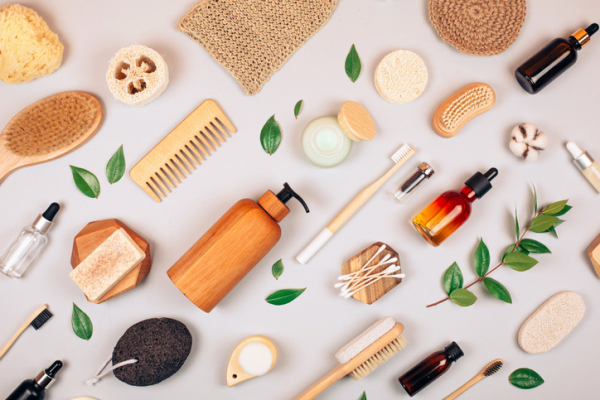
Have you exfoliated lately?

Social media has a way of making the ho-hum seem fresh and novel. Case in point: exfoliation, the process of removing dead cells from the skin’s outer layer. Anyone scrolling through TikTok lately might be convinced this longtime skin care approach can transform something old — let’s say our aging epidermis — into like-new skin.
But a Harvard dermatologist says that’s asking too much.
“I don’t think exfoliation is going to fix anybody’s wrinkles,” says Rachel Reynolds, MD, interim chair of dermatology at Harvard-affiliated Beth Israel Deaconess Medical Center. While exfoliation offers definite benefits, it can also irritate and inflame the skin if you don’t do it carefully, or use tools or chemicals your skin doesn’t tolerate.
How is exfoliation done?
There are two main ways to exfoliate: mechanical and chemical. Each boasts specific advantages.
- Mechanical (or physical) exfoliation uses a tool such as a brush or loofah sponge, or a scrub containing abrasive particles, to physically remove dead skin cells. “Mechanical exfoliation can improve skin luster by taking off a dead layer of skin that can make it look dull,” Dr. Reynolds says. “And it can help unclog pores a bit, which can reduce some types of acne.”
- Chemical exfoliation uses chemicals — often alpha and beta hydroxy acids or salicylic acid — to liquify dead skin cells. “Chemical exfoliants work on a more micro-level to help dissolve excess skin cells and reduce uneven pigmentation sitting at the surface of the skin,” she explains. “They also restore skin glow, improve acne, and give the skin a little more shine.”
Why do skin care products so often promote exfoliation?
Perhaps hundreds of commercially available skin care products — from body washes to cleansers to face masks — are labeled as exfoliating, Dr. Reynolds notes. But she’s skeptical about why such a wide array of items plug this feature so prominently.
“It’s advantageous for a cosmetics company to sell consumers more products in a skin care line,” she says. “But it’s buyer beware, because this is a completely unregulated market, and cosmetic companies can make claims that don’t have to be substantiated in actual clinical trials.”
Do we need to exfoliate our skin?
No. “Nothing happens if you don’t exfoliate — you just walk around with bumpy or slightly dry skin, which is inconsequential except for cosmetic reasons,” Dr. Reynolds says.
“No one has to exfoliate, but it can be helpful to exfoliate the arms and legs,” she adds. “As we age, these areas get more dry than other parts of the body, and people notice they build up a lot more flaking skin and an almost fish-scale appearance.”
That phenomenon may or may not be a sign of keratosis pilaris, a common but harmless skin condition characterized by rough, bumpy “chicken skin” on the upper arms and thighs. Physical exfoliators are a good first choice because keratosis pilaris covers areas that have tougher skin than the face, she says. But it’s fine to use a cleanser or lotion containing a chemical exfoliant instead. Either type can improve skin texture and the skin’s appearance.
Can exfoliation harm our skin?
Yes. Both physical and chemical exfoliation techniques can do more harm than good, depending on several factors. Sensitive skin is more likely to become irritated or inflamed by any exfoliant. And overdoing it — whether by rubbing too hard or using a product with higher concentrations of acid — can trigger irritant contact dermatitis, which can look red, angry, and chapped.
“Physical exfoliation that’s done too harshly can also aggravate inflammatory acne, making it worse,” Dr. Reynolds says. “Also, exfoliating can make you more prone to sunburn.”
What are the safest ways to exfoliate?
Dr. Reynolds recommends chemical exfoliants over physical versions. “Sometimes the abrasives in those apricot scrubs, for example, can go too far, aggravating the skin and creating inflammation,” she says.
She offers these additional tips to exfoliate safely:
- If you haven’t exfoliated before, start with a simple washcloth to determine how well your skin responds to mild attempts at physical exfoliation.
- Then try gentler chemical exfoliants, such as lower concentrations of hydroxy acids or salicylic acid. Work your way up to stronger concentrations only if needed.
- If you’re hoping to eradicate stubborn skin problems such as melasma (brown facial patches) or comedonal acne (small, skin-colored bumps often on the forehead or chin), consider undergoing a chemical peel at a dermatologist’s office.
Don’t exfoliate every day. “At most, do it two or three times a week,” Dr. Reynolds says. “Your skin needs to repair itself in between exfoliation episodes.”
About the Author

Maureen Salamon, Executive Editor, Harvard Women's Health Watch
Maureen Salamon is executive editor of Harvard Women’s Health Watch. She began her career as a newspaper reporter and later covered health and medicine for a wide variety of websites, magazines, and hospitals. Her work has … See Full Bio View all posts by Maureen Salamon
About the Reviewer

Howard E. LeWine, MD, Chief Medical Editor, Harvard Health Publishing
Dr. Howard LeWine is a practicing internist at Brigham and Women’s Hospital in Boston, Chief Medical Editor at Harvard Health Publishing, and editor in chief of Harvard Men’s Health Watch. See Full Bio View all posts by Howard E. LeWine, MD

Moving from couch to 5K

Need a little motivation and structure to ramp up your walking routine? Want to wake up your workouts but not quite ready for a mud run? Consider trying a couch-to-5K program.
Dr. Adam Tenforde, medical director of the Spaulding National Running Center at Harvard-affiliated Spaulding Rehabilitation Network and a sports medicine physician at Mass General Brigham Sports Medicine, shares tips on what to know and do before lacing up your sneakers.
What is a couch-to-5K program?
These free or low-cost coaching plans are designed to help would-be runners train for a 5-kilometer race, which is about 3.1 miles. The programs are available online, or as apps or podcasts. They typically feature timed walking and running intervals that gradually phase out the walking over a period of about nine weeks.
Why try a couch-to-5K program?
“One purpose of a couch-to-5K program is to give you time to acclimate and start to enjoy the benefits of running and the sense of accomplishment of completing a distance safely,” says Dr. Tenforde. Running provides many cardiovascular benefits, such as lower blood pressure and a reduced cholesterol level, as well as an enhanced sense of well-being, he adds.
What’s more, adding even short bursts of running or other vigorous physical activity to a workout — a practice known as high-intensity interval training or HIIT — appears to help improve mental health, according to a study that pooled findings from 58 randomized trials of HIIT.
Are you ready to tackle a couch-to-5K?
Even though the couch-to-5K programs sound as though they’re geared for completely sedentary couch potatoes, that’s not necessarily true, Dr. Tenforde cautions. These programs often assume you can walk continuously for 30 minutes, which doesn’t apply to everyone.
For some people, an even easier, more gradual training regimen may be more appropriate. Also, keep in mind that you don’t have to run to do a 5K. Many of these races also encourage walkers to participate as well. You’ll still reap the other rewards from committing to a race, such as being more challenged and motivated — and possibly more connected to your community. Many charitable “fun runs” benefit local schools or needy families. Some are in memory of people affected by illness or tragedy. Visit Running in the USA to find 5K races near you.
What to do before you start
If you’re planning to walk or run your first 5K, get your doctor’s approval before you start training. That’s especially important if you have heart disease or are at risk for it.
Comfortable walking or running shoes are a wise investment. Shoes that are too old or too tight in the toe box can cause or aggravate a bunion, a bony bump at the outer base of the big toe. Despite suggestions that people with flat feet or high arches need specific types of shoes, studies have found that neutral shoes (designed for average feet) work well for almost everyone. Walk or jog around the store when you try them on to make sure they feel good and fit properly.
You don’t need to buy special clothes; regular sweat pants or comfortable shorts and a t-shirt will suffice. Women should consider getting a supportive sports bra, however.
Go slow and steady when training
- Always include a warm-up and cool-down — a few minutes of slow walking or jogging — with every exercise session.
- If you haven’t been exercising regularly, start by walking just five or 10 minutes a day, three days a week. Or, if you’re already a regular walker, add some short stints of jogging to each walking session.
- Gradually add minutes and days over the following four to six weeks.
- Once you’re up to 30 minutes a day, check how far you’re traveling. Keep increasing your distance every week until you reach 5 kilometers. Then slowly phase in more jogging and less walking over your route if you like.
Remember that you can always repeat a week. You’re less likely to sustain an injury if you make slow, steady progress. Pay close attention to your body and don’t push yourself too much, Dr. Tenforde advises. Former athletes who haven’t run in years may think they can pick up where they left off, but that’s not a smart move — they should also start low and go slow.
For a good couch-to-5K guide, try this beginner’s program from the United Kingdom’s National Health Service.
About the Author

Julie Corliss, Executive Editor, Harvard Heart Letter
Julie Corliss is the executive editor of the Harvard Heart Letter. Before working at Harvard, she was a medical writer and editor at HealthNews, a consumer newsletter affiliated with The New England Journal of Medicine. She … See Full Bio View all posts by Julie Corliss
About the Reviewer

Howard E. LeWine, MD, Chief Medical Editor, Harvard Health Publishing
Dr. Howard LeWine is a practicing internist at Brigham and Women’s Hospital in Boston, Chief Medical Editor at Harvard Health Publishing, and editor in chief of Harvard Men’s Health Watch. See Full Bio View all posts by Howard E. LeWine, MD